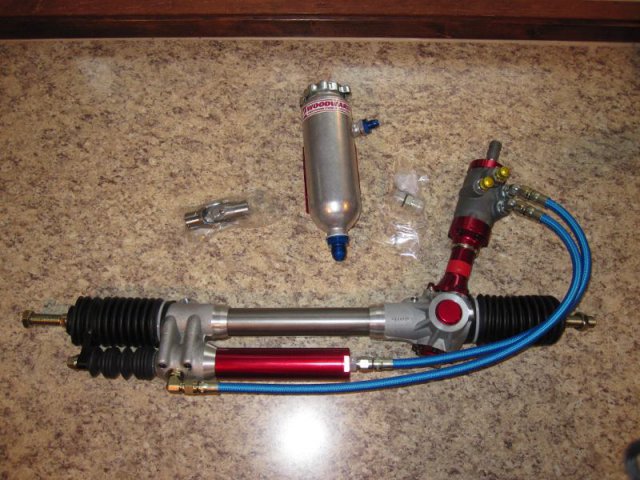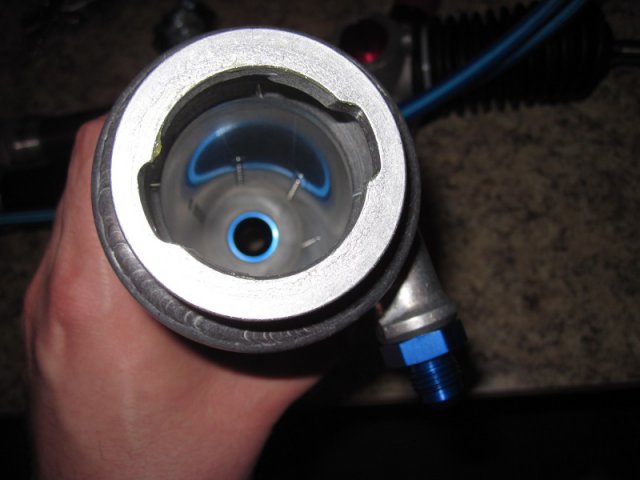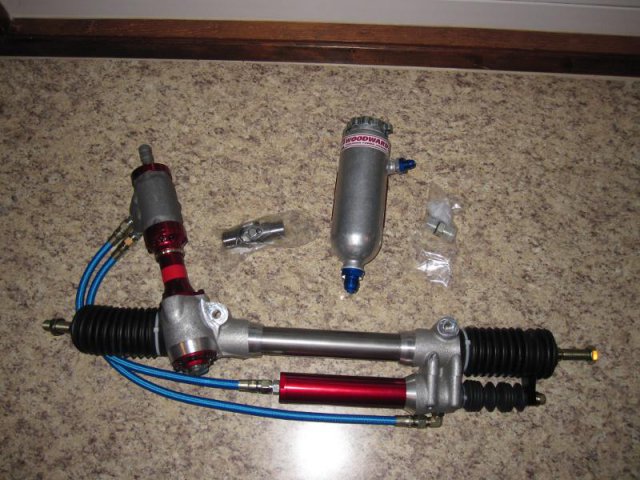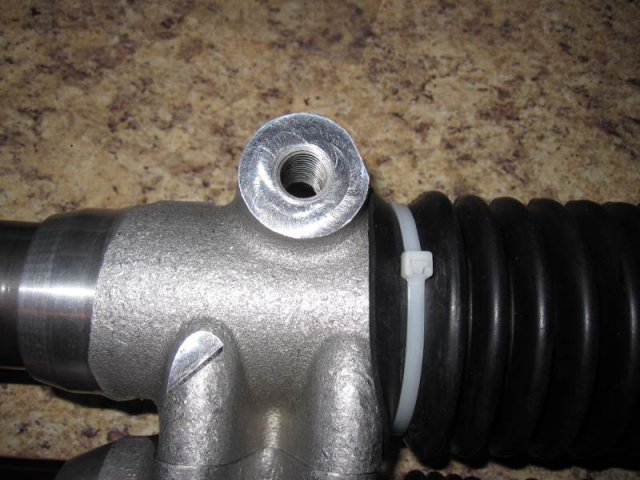-
Posts
13742 -
Joined
-
Last visited
-
Days Won
67
Content Type
Profiles
Forums
Blogs
Events
Gallery
Downloads
Store
Everything posted by JMortensen
-
Race Car Rear wing and Aero???? 240 IMSA GTU Car
JMortensen replied to cobramatt's topic in Body Kits & Paint
The air going through the radiator isn't moving very fast, so the downforce created by the slope of the ramp isn't going to be much if anything. What exhausting the radiator air out the top (or the sides) does is prevent if from going under the car and particularly under the hood, and that's where the downforce comes from. I love the Janspeed hillclimb video for showing the effect of air under the hood. Right at the end there you can see the thin FG hood flexing up on the sides and in the middle due to the relative pressure underneath and on top of the hood. Just think of how hard you would have to push on that hood to get that kind of movement. That's upforce created by running without a radiator exhaust. -
Race Car Rear wing and Aero???? 240 IMSA GTU Car
JMortensen replied to cobramatt's topic in Body Kits & Paint
You have to keep in mind what the test was done for. It wasn't done to see what would make maximum downforce. It was done on relatively stock Z's to see what the typical bolt on aero mods did. In that respect the test was very effective and answered your questions directly. I think you can pretty well just look at the numbers and draw your own conclusions. It could have been a lot more useful to you and me if it were done specifically to see what worked to make maximum downforce, but that really wasn't the purpose and it's not really fair to the guys who did the testing to complain about it now. Most (all?) of the arguments surrounding the wind tunnel testing have to do with things that WEREN'T tested, where people are speculating on whether something could have worked, or whether X which wasn't in the test works better than Y which was. Only real way to settle those arguments is another test. If your louvers face back, then you might just cover the NACA ducts in the hood. I know Richard (260DET) did that on one of his hoods.. -
I had thrown mine away, so I'm pretty sure I did the right thing in buying new linkage...
-
Race Car Rear wing and Aero???? 240 IMSA GTU Car
JMortensen replied to cobramatt's topic in Body Kits & Paint
Oops, wrong link. Here you go: http://forums.pelica...g-many-pix.html EDIT--I think the first thing I'd do is get rid of that hood. NACA ducts are going to put more air under the hood, and it looks like the louvers face the front too, so they would also push air into the engine compartment. You want the exact opposite. -
Race Car Rear wing and Aero???? 240 IMSA GTU Car
JMortensen replied to cobramatt's topic in Body Kits & Paint
You might start by reading the wind tunnel test results and some of the other threads in the aero section. You can run the spoiler and a wing (link shows a 911 with ducktail and wing that he built from scratch): http://forums.pelicanparts.com/porsche-911-technical-forum/294153-poor-mans-aero-wingin-3.html You'll still need to balance the front end with the back. The back is pretty easy, just keep adding wing until you get what you want. The front is where it gets a little complicated, as it is harder to decide what to do to get downforce there. Your question is potentially huge and open ended, so I'd suggest you do a little research and then come back with some more specific questions. Otherwise you're probably just going to get generic recommendations like building a duct from the front to the radiator, splitter, wing, vortex generators, etc. You'll likely be blazing trails for the rest of us as well. If you get really into this subject you might try a couple books like Competition Car Downforce and Competition Car Aero by McBeath or Race Car Aerodynamics by Katz. Every car is different and without another wind tunnel test what you'll have is a lot of speculation and experimentation, but there are some general overriding principles that should work and be applicable to your car. Looks like a hell of a car. I'll be keeping an eye out to see what you end up with and how it works out for you. -
Rear Fender cut out for ZG Flare
JMortensen replied to Raptor280Z's topic in S30 Series - 240z, 260z, 280z
Tough to say for sure due to the angle of the picture, but it doesn't really look like you've cut out enough metal. If your tools are at this 40 mile away location, you might take care of that before you move the car. -
Sure thing. Glad it's back together, and FWIW I think R200's are just kinda noisy, especially if you're running poly bushings. I'd call it done and drive it.
-
Not having owned a turbo it seems to me that a lot of people with turbos going out pull an intake elbow off and see oil in there. Might be worth a shot. I don't think 70 miles is enough to break in rings, especially moly rings. I think smoke on decel is a sign of ring problems for NA cars too.
-
I believe my bro-in-law has some linkages around (unless he sent me the last one). You can email him at Mat M AT m2differentials DOT com. I wouldn't jump to the conclusion that the linkage is bad though. I'd be checking fuses and looking at the wiring for the motor first.
-
Woodward power steering project
JMortensen replied to JMortensen's topic in Brakes, Wheels, Suspension and Chassis
Tony warned me that the rack would be so much more powerful that I should beef up the frame rails to deal with the additional strain. I had already done some strengthening of the frame rails, but the Z crossmember is not the strongest looking thing and I don't really see a good way to increase its rigidity. Just playing around with the rack and an old crossmember I figured out that the old 6 cylinder engine mount towers had to come off, so those got cut. No biggee as I need to fab mounts for the L33 V8 anyway. Then I realized that the horns that stick off the front that hold the stock rack had to get cut back just to get the rack in position, so I did that. At this point I was able to get the rack positioned essentially in the stock position, but about 1/4" higher. Moving the rack back to the stock position fore/aft negates the work I did to move the rack back, but after graphing it out on the Ackerman thread, the difference will be minimal, so I'm not worried about it. The rack mount is my biggest dilemma right now. I think the most logical way to mount the rack is to weld two pieces of angle iron to the front of the crossmember so that the flat part of the rack sits right on them. This may improve the rigidity a bit over the long unsupported saddles that the stock rack used, but they're not exactly what I would call "overbuilt". I thought of using a long piece of angle iron all the way across the front and I think that would be sturdier, but then there really wouldn't be a good way to put the bolts in, unless I drilled a big hole in the bottom of the crossmember, although that's sounding like it will be the best option at this point. About the only thing I can think to do with regards to the crossmember would be to add a folded sheet metal gusset like a taco gusset between the crossmember and the frame rail, so that the lateral loads imparted into the frame go through two sides of the frame rail, instead of just the bottom. If anyone has any other ideas or previous experience, I'm all ears. -
Sounds like clutch chatter. Solution is to add friction modifier until it goes away. SWEPCO has enough that a stock LSD won't chatter. I haven't tried it with the extra clutches or with a shimmed LSD, but adding the modifier isn't a big problem either way. Clutch chatter with no additive can be really bad. I installed a Toyota LSD that I installed without additive and it sounded like the differential is going to fall out of the back of the truck. I thought something had gone horribly wrong. Added some friction modifier, and it worked silently.
-
Woodward power steering project
JMortensen replied to JMortensen's topic in Brakes, Wheels, Suspension and Chassis
Got the rack today. Looks good. Now I just have to figure out how to install it. I thought this thing would have your typical circle track rack type of setup where the rack attached with three screws on each end. Looks like it attaches with one big ass bolt. I haven't measured, but I think it's 7/16", and there is a machined flat spot on the bottom of the rack where whatever mount is used will sit. I see this as good in that you can adjust bumpsteer out with shims fairly easily. It also appears that the pinion doesn't have much vertical angle to it, so that leads me to believe the rack will have to be mounted pretty high for the pinion to clear the crossmember. I could tilt the mounts, but then the hydraulic cylinder would be hanging down lower than the crossmember, which is already going to be pretty low. Don't want that. I guess the other option is to move the rack forward again, and that might unfortunately be the only solution. At least now after having looked at the Ackerman issue in detail I realize that I wouldn't be giving up much to move it forward a little bit. I guess I'll just have to start playing with it and see what works, my biggest fear is that I can't get it in without redesigning the crossmember. Not that this would be a huge project in comparison to some of the others I've done, but it's just one more thing to do, and I need less of those. The reservoir for the ps fluid is a two layered can where the feed to the pump is at the bottom of the center can and the return dumps into the outer shell. There are perforated holes about 3/16" in diameter in the inner can to keep aeration to a minimum, and the can is nice and tall to keep any bubbles that make it through at the top. Came with a nice bracket as well. Some pictures: -
Moveable aerodynamics on the Ford Fusion
JMortensen replied to proxlamus©'s topic in Windtunnel Test Results and Analysis
If you can duct the inlet to the radiator, this will lower drag and force all the air that goes into the front through the radiator. If you can duct it back out, even better. If you're doing just one or the other, ducting > moveable vents. -
Yep. With the more aggressive ramp angles as well.
-
In particular get a picture of any holes or windows in the carrier.
-
Just keep off of the Dukes of Hazzard type jumps, and the springs won't fall out. It's normal for lowering springs to be loose like that.
-
Welded diffs are popular with racers because of cost. If you need several different ratios for different tracks, welding costs several dollars, and LSD's for 3 or 4 diffs might cost thousands. John is right that they didn't do reverse cut gears for the front R180s, it's just the same diff flipped around and put in the front end driven backwards. Sometimes weird stuff happens to front diffs on 4x4s, like they get water in them when a car is 4 wheeling and then the water isn't drained out. The rear boils off the water quickly as the car is driven, and the front doesn't because it isn't moving unless the transfer case is engaged, and that causes bearing damage. Things like that. On the other hand, most front diffs have very little use, so if they don't have that oddball damage, they're usually in like new shape. I'd open that one up and have a look at the ring and pinion and the bearings and see if you can easily tell what the problem is, check backlash too. If it looks OK and backlash is in spec, then I would probably try to find another diff. You'll likely spend more trying to figure that one out than you will just buying another one. I think it is unlikely that the pinion is loose, as that would likely cause very severe problems in a short period of time. You can get the K series 4.11 R180 out of the later 240SXs and they're pretty easy to find from what I understand. BJ Hines supplied info on how to convert them from clip in axles to bolt in axles for the big diff thread here: http://forums.hybridz.org/index.php/topic/49194-differential-cv-lsd-hp-torque-r160-r180-r200-r230-diff-mount/
-
Roadcourse Tires
JMortensen replied to wondersparrow's topic in Brakes, Wheels, Suspension and Chassis
http://www.corner-carvers.com/forums/showthread.php?t=484& -
I don't know the specs on that strut. Coffey would be better able to answer that question.
-
Roadcourse Tires
JMortensen replied to wondersparrow's topic in Brakes, Wheels, Suspension and Chassis
There is a shot of a Z with cantilevered slicks on John's website http://www.betamotorsports.com. -
Depends. You really would need to section to the shorter strut and then add in bump stop length until you could have the travel you want without any binding. To check for binding you need to remove the spring and the sway bar from the opposite side, and then move the suspension through its range of motion BY HAND. If you do it with a floor jack there's a good chance of missing the bind completely. The risk in this is that if you section too short you might not have enough droop when you're done.
-
Be careful sectioning too much and/or lowering your car too far. You eventually get into a situation where suspension hits frame, tie rods bottom out, etc. I can't tell you where exactly those problems happen, but I can tell you that with stock rear control arms and normally sectioned struts I was able to hit the rear frame with the control arm. You could put a longer bumpstop in there to prevent metal to metal contact if there is any. In the front with rod end sway bar end links I had to try 2 or 3 times to set them up so that they didn't bind up as well. If this stuff binds on a big bump something could bend or break, not a good thing. Bumpsteer also gets pretty nasty when the car is super low, and bumpsteer spacers don't fix bump steer. Read the bumpsteer FAQ for more on that if you're going to go really low.
-
Roadcourse Tires
JMortensen replied to wondersparrow's topic in Brakes, Wheels, Suspension and Chassis
For a 15 x 7 you should be using a cantilevered slick if you want a 9" wide tire. If you're going with DOT's, I'd run a 225 max. Check out used slicks. Not sure how available used cantilevers are, but the tires will at least fit the rim correctly. -
If you're feeling adventurous you could take an inner Subie CV and and out 300ZXT CV and have a shaft made splined for the Subie inner and the Nissan outer. Then you would still need MM's CV adapters. I think that a V8, especially one that is going to be beat on, deserves upgraded stub axles as well. So yeah, it's going to be expensive unless you just run stock stubs, and then you've got a weak link in the chain.
-
coilover 8 inch spring?
JMortensen replied to copperdatsun76's topic in Brakes, Wheels, Suspension and Chassis
Different springs have different free lengths and bound lengths. If you look up Eibach's website they have .pdf catalogs that have the info, but it will vary a bit from Eibach to Hyperco to whatever other source you use for springs.




